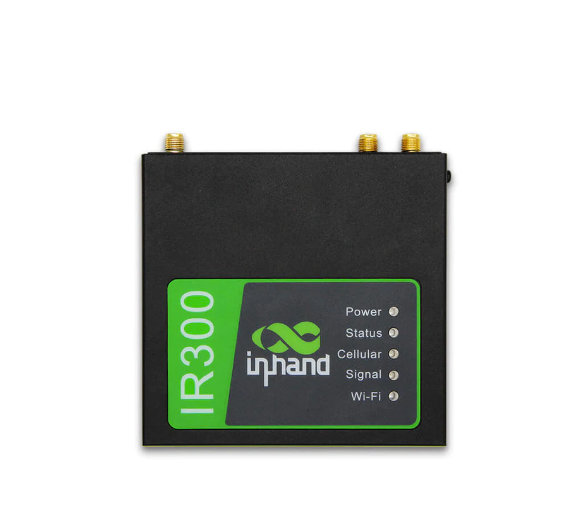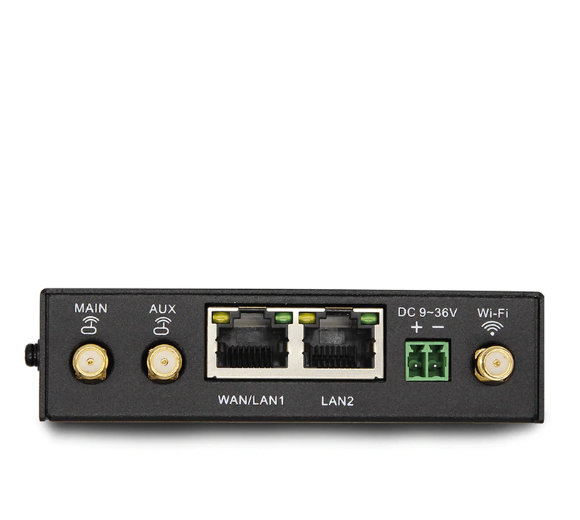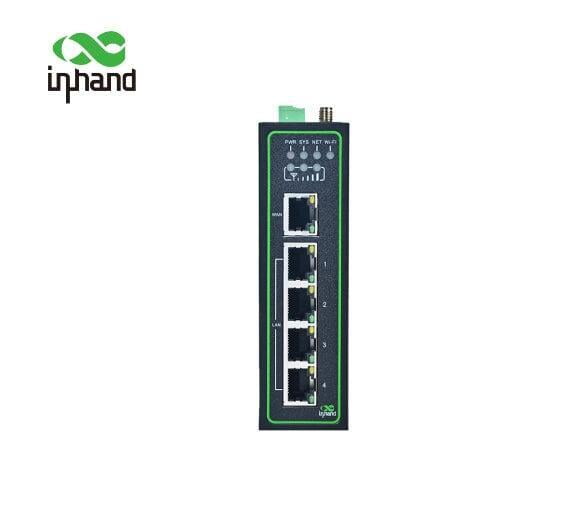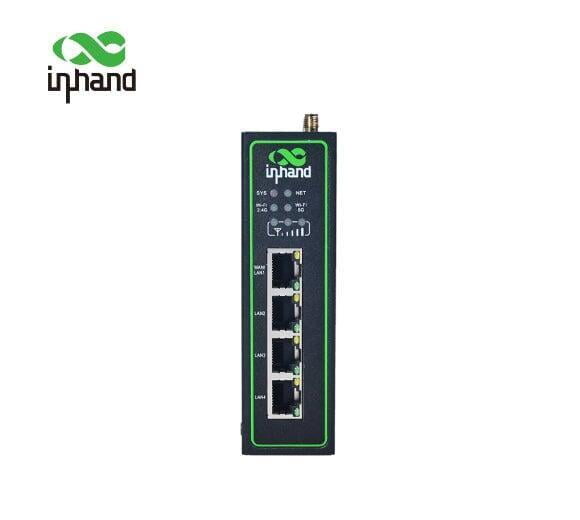


IR302 Industrial LTE Router
- LTE Cat4/CatM/Cat1、NB-IoT
- Dual Ethernet Ports,Wi-Fi
- Redundant design: Dual SIM, dual-link backup
- High security with multiple VPN
- Industrial-grade, compact design
Features
Technical
Part Numbers
Download
Features
Technical
| IR302 | Technical |
|---|---|
| CPU | 580MHz |
| Memory | 128MB DDR2 |
| Flash | 32MB SPI |
| SIM | Dual SIM d |
| Network | GSM/GPRS/EDGE、UMTS/HSPA+/EVDO/TD-SCDMA、TDD-LTE/FDD-LTE |
| WAN/LAN | 2*10/100Mbps, WAN/LAN port |
| Power | 2*PIN industrial terminals, DC9-36V, overvoltage protection, reverse protection |
| Serial port | Optional, 1*RS232 |
| I/O interface | Optional, supports 2*I/O, DI or DO configurable |
| Wi-Fi | Optional IEEE 802.11b/g/n, rate 150Mbps Support AP, Client, WDS mode Support open system, shared key, WPA/WPA2 certification Support WEP/TKIP/AES encryption Range 80 meters (actual transmission distance varies with the actual environment) |
| Grounding terminal | Support |
| Network access | APN, VPDN; Support dual APN access |
| Access authentication | CHAP/PAP |
| LAN protocol | Support ARP |
| WAN protocol | Support DHCP, PPPoE, PPP |
| IP application | Support Ping, Trace, DHCP Server, DHCP Relay, DHCP Client, DNS relay, DDNS, Telnet |
| IP routing | Support static routing |
| NAT | Support network address translation |
| Firewall | Stateful packet inspection (SPI), DoS prevention service, packet filtering, access control list (ACL), IP-MAC binding |
| Data security | Support PPTP, L2TP, GRE, IPSEC VPN (IKEv1, IKEv2), OPENVPN etc VPN functions, CA certificate |
| Backup | Support VRRP backup, link redundancy, dual SIM card standby |
| Link failure detection | Support link failure detection, new link automatic connection |
| Embedded Watchdog | Device operation self-protection, device operation self-recovery |
| Configuration mode | Support telnet, web, tftp and console configuration modes |
| Upgrade mode | Support web upgrade, DM upgrade mode |
| Log | Support local system log, remote log, serial port log output |
| SMS | Status query, restart |
| Network diagnosis | Support Ping, TraceRoute, Sniffer (network packet tools) |
| Mounting | Panel mounting; Rail mounting |
| Shell | Metal shell, IP30 |
| Dimensions(mm) | 90x30x25 |
| Weight(g) | 259 |
| Cooling | Fanless cooling |
| Power input | DC 9-36V |
| Working temperature | -20-70℃ |
| Storage temperature | -40-85℃ |
| Ambient temperature | 5-95%RH (unfrozen) |
| EMC compliance | Static EN61000-4-2, level 2 Radiation Electric Field EN61000-4-3, level 2 Pulsed Electric Field EN61000-4-4, level 2 Surge EN61000-4-5, level 2 Conducted Disturbance Immunity EN61000-4-6 ,level 2 Shock Wave Resistance EN61000-4-12,level 2 Power Frequency Magnetic Field Resistance EN61000-4-8, horizontal / vertical 400A/m (>level 2) |
| Certification | CE, CB, UKCA, E-MARK, FCC, IC, PTCRB, AT&T, Verizon, T-Mobile, RCM, CCC, EAC&FAC, UL, ANATEL, MIC&JATE, IEC 62443 |
Part Numbers
| Part Numbers | Region & Network & Band | Wi-Fi | Serial and I/O |
|---|---|---|---|
| IR302-FQ58 | Europe & APAC LTE CAT4 FDD: B1/B3/B7/B8/B20/B28A WCDMA: B1/B8 GSM: B3/B8 | √ | √ |
| IR302-FQ58-L | Europe & APAC LTE CAT4 FDD: B1/B3/B5/B7/B8/B20/B28 TDD: B38/B40/B41 WCDMA: B1/B5/B8 GSM/EDGE: B3/B8 | √ | √ |
| IR302-FQ53 | EMEA LTE CAT1 FDD: B1/B3/B7/B8/B20/B28 WCDMA: B1/B8 GSM/EDGE: B3/B8 | √ | √ |
| IR302-FQ38 | North America AT&T, Verizon LTE CAT4 FDD: B2/B4/B5/B12/B13/B14/B66/B71 WCDMA: B2/B4/B5 | √ | √ |
| IR302-FQ33 | North America AT&T, Verizon LTE CAT1 FDD: B2/B4/ B5/B12/B13/B25/B26 WCDMA: B2/B4/B5 | √ | √ |
| IR302-FQ68 | Latin America LTE CAT4 FDD: B1/B2/B3/B4/B5/B7/B8/B28/B66 TDD: B40 WCDMA: B1/B2/B4/B5/B8 GSM: B2/B3/B5/B8 | √ | √ |
| IR302-FQ78 | Australia, Latin America LTE CAT4 FDD: B1/B2/B3/B4/B5/B7/B8/B28 TDD: B40 WCDMA: B1/B2/B5/B8 GSM: B2/B3/B5/B8 | √ | √ |
| IR302-FQ88 | Japan LTE CAT4 FDD: B1/B3/B8/B18/B19/B26 TDD: B41 WCDMA: B1/B6/B8/B19 | √ | √ |
| IR302-LQ28 | China LTE CAT4 FDD:B1/B3/B5/B8 TDD:B34/B38/B39/B40/B41 WADMA:B1/B5/B8 GSM:B3/B8 | √ | √ |
| IR302-EN00 | Global No 4G/3G module | √ | √ |
Download
Related Products
InRouter305 Industrial 4G Router
5*10/100Mbps, 2 *NANO SIM
1*RS232, 1*RS485, 4*DI/DO, Wi-Fi
4G (LTE CAT6/CAT4)
9~36V DC, EMC level 3
4G (LTE CAT6/CAT4)
9~36V DC, EMC level 3

InRouter315 Router
5*10/100Mbps, 2 *NANO SIM
1*RS232, 1*RS485, 4*DI/DO, Wi-Fi
4G9~36V DC
EMC level 3
1*RS232, 1*RS485, 4*DI/DO, Wi-Fi
4G9~36V DC
EMC level 3

InRouter624 Router
4*10/100Mbps, 2 *NANO SIM
1*RS232, 1*RS485
5G/4G9~48V DC
1*RS232, 1*RS485
5G/4G9~48V DC
EMC level 3
FAQ
Interested in the industrial router?
Interested in the industrial router?
Please fill the form and we will get back to you shortly.

